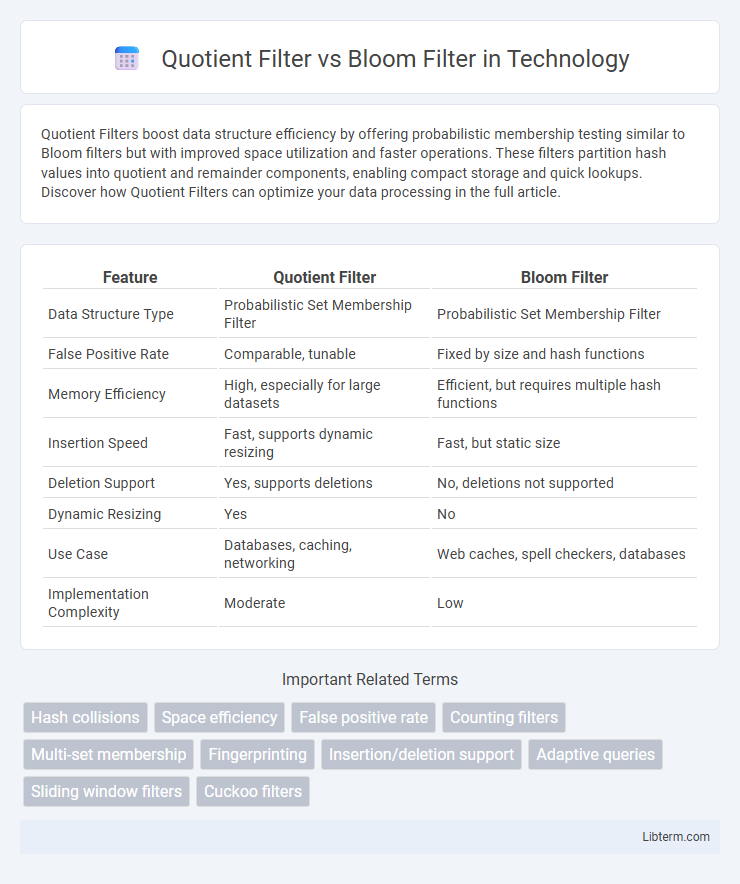Quotient Filters boost data structure efficiency by offering probabilistic membership testing similar to Bloom filters but with improved space utilization and faster operations. These filters partition hash values into quotient and remainder components, enabling compact storage and quick lookups. Discover how Quotient Filters can optimize your data processing in the full article.
Table of Comparison
| Feature | Quotient Filter | Bloom Filter |
|---|---|---|
| Data Structure Type | Probabilistic Set Membership Filter | Probabilistic Set Membership Filter |
| False Positive Rate | Comparable, tunable | Fixed by size and hash functions |
| Memory Efficiency | High, especially for large datasets | Efficient, but requires multiple hash functions |
| Insertion Speed | Fast, supports dynamic resizing | Fast, but static size |
| Deletion Support | Yes, supports deletions | No, deletions not supported |
| Dynamic Resizing | Yes | No |
| Use Case | Databases, caching, networking | Web caches, spell checkers, databases |
| Implementation Complexity | Moderate | Low |
Introduction to Probabilistic Data Structures
Probabilistic data structures like Quotient Filters and Bloom Filters provide space-efficient solutions for approximate membership queries with a controlled false positive rate. Bloom Filters use multiple hash functions to set bits in a bit array, enabling fast membership tests but lacking deletion support and suffering from false positives that increase with fill ratio. Quotient Filters improve on Bloom Filters by storing compact fingerprints with partial keys in a hash table, supporting dynamic resizing and deletions while offering comparable false positive rates and better cache efficiency.
What is a Bloom Filter?
A Bloom Filter is a space-efficient probabilistic data structure used to test whether an element is a member of a set, allowing for false positives but no false negatives. It uses multiple hash functions to map elements to a fixed-size bit array, where bits are set to indicate the presence of an element. Compared to Quotient Filters, Bloom Filters typically offer faster insertions and queries but may require more memory and have higher false positive rates.
What is a Quotient Filter?
A Quotient Filter is a space-efficient probabilistic data structure used for approximate membership testing, similar to a Bloom Filter but with distinct advantages in handling deletions and dynamic resizing. It partitions hashed keys into a quotient and a remainder to store information compactly in a contiguous array, enabling faster lookups and lower false positive rates under certain workloads. This structure is particularly effective in workloads requiring dynamic updates, as it supports insertions and deletions without needing complete rebuilds.
Core Principles: How Bloom and Quotient Filters Work
Bloom filters utilize multiple hash functions to map elements to bits in a fixed-size bit array, indicating possible membership with low memory usage but allowing false positives. Quotient filters divide hashed values into a quotient and remainder, storing remainders in a compact, sorted table that supports efficient insertions, deletions, and membership queries with fewer false positives. Both structures optimize space for probabilistic membership testing but differ fundamentally in data organization and operational efficiency.
Memory Efficiency Comparison
Quotient Filters use a compact fingerprinting technique that dynamically resizes to maintain high memory efficiency, often requiring less space than Bloom Filters for the same false positive rate. Bloom Filters, while simple and fast, generally consume more memory due to fixed-size bit arrays and the need for multiple hash functions. Empirical studies show Quotient Filters can achieve up to 30% better memory efficiency compared to Bloom Filters in large-scale membership testing scenarios.
Query and Insertion Performance
Quotient filters offer faster query performance than Bloom filters due to their ability to store and retrieve fingerprints with fewer hash functions, reducing lookup time. Insertion operations in quotient filters are more efficient because they minimize the number of memory accesses required to place elements compared to Bloom filters' multiple bit updates. The structural design of quotient filters also enables better support for deletions and lower false positive rates at comparable space, enhancing overall performance in dynamic scenarios.
False Positive Rates: Bloom vs Quotient Filters
Bloom filters typically exhibit lower false positive rates at comparable memory sizes due to multiple independent hash functions distributing bits more uniformly. Quotient filters offer competitive false positive rates while enabling dynamic resizing and deletions, which traditional Bloom filters lack. Analysis shows that for workloads requiring adaptive structures, quotient filters balance false positive rates with operational flexibility more effectively.
Scalability and Dynamic Operations
Quotient Filters offer superior scalability over Bloom Filters by supporting dynamic resizing without the need to rebuild the entire data structure, enabling efficient handling of growing datasets. Unlike Bloom Filters, Quotient Filters allow for dynamic insertions and deletions with consistent performance, making them suitable for applications with evolving data streams. This flexibility in dynamic operations positions Quotient Filters as a more adaptable choice for scalable, real-time processing environments.
Use Cases and Application Scenarios
Quotient Filters excel in scenarios requiring dynamic set membership with support for deletion and high space efficiency, making them ideal for database indexing and cache filtering. Bloom Filters are preferred for applications demanding fast membership queries with minimal false positives, such as distributed systems, network security, and web caching. Use cases involving real-time analytics and approximate membership tests benefit from Bloom Filters' speed, whereas Quotient Filters suit environments with evolving datasets needing more flexible update operations.
Conclusion: Choosing Between Bloom and Quotient Filters
Quotient filters offer a space-efficient alternative to Bloom filters with support for deleting elements and dynamic resizing, making them ideal for applications requiring frequent updates. Bloom filters excel in simplicity and speed when only approximate membership queries with false positives are acceptable, but they lack native deletion capabilities. Selecting between Bloom and Quotient filters depends on the specific use case's requirements for update flexibility, space constraints, and false positive tolerance.
Quotient Filter Infographic

 libterm.com
libterm.com